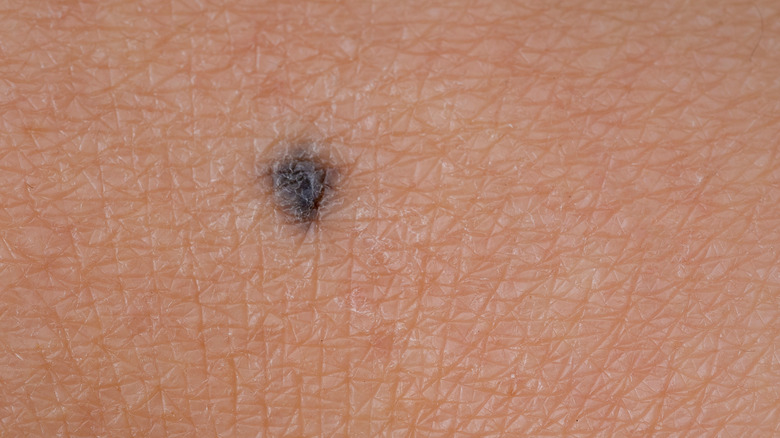What You Should Do If You Find A Blue Nevus Mole On Your Body
If you've ever conducted a skin self-exam and stumbled upon a mole with a blue or grayish tint, it's understandable that you might find it peculiar, or even worrisome.
Known as a blue nevus, this skin growth can come in many different forms. However, most are usually categorized as one of two types: common blue nevus or cellular blue nevus (via Medical News Today). A common blue nevus usually takes on a small, round or oval shape. Whether appearing flat or raised, a common blue nevus is usually about 1 to 5 millimeters in diameter. On the other hand, a cellular blue nevus is more often protruding from the skin and usually measures about 1 to 3 centimeters in diameter.
According to Blue Nevus, common blue nevus are generally observed more in young adults, often on the face, hands, or feet. Conversely, middle-aged adults tend to be more prone to cellular blue nevus, which usually develop on the buttocks or around the tailbone.
Should you be worried about a blue nevus mole?
So what exactly gives a blue nevus its signature blue coloring in the first place? Dermatology experts Dr. Shari Lipner and Dr. Nada Elbuluk explain to Self that a blue nevus mole can occur when melanin-producing cells fail to make their way to the skin's surface and instead become stuck deeper underneath the epidermis. However, that bluish tint we see is not actually the real color of the mole at all. Instead, it has to do with how our eye is receiving the reflection of light, a process that has been termed the Tyndall effect (via Blue Nevus).
As unusual as they may appear, blue nevi are most often non-cancerous and do not generally pose risk of complications, notes Medical News Today. When it comes to cellular blue nevus, however, there is a minimal chance of the growth becoming cancerous. Therefore, it's important to consult with your doctor if you notice the presence of one. A physician can generally diagnose a blue nevus by using a dermatoscope to magnify the area and examine it. However, they can also perform a biopsy if needed to ensure the growth is not something concerning.
Skin changes to be on the lookout for
Most blue nevus moles are benign. Even so, there are some signs one should be on the lookout for indicating that a trip to your dermatologist may be warranted. These signs include a blue nevus that pops up unexpectedly, a pre-existing blue nevus that undergoes changes in appearance such as color or size, a blue nevus that exceeds 1 centimeter in diameter, or if you experience itching, oozing, bleeding, or pain at the mole site.
In some instances, your doctor may opt for removal, particularly if a blue nevus is found on the scalp, changes shape, becomes larger, or if your dermatologist thinks it may be malignant. Usually this involves having the mole being surgically cut out or shaved off, and scarring after the fact is not uncommon. For those interested in removing a blue nevus for aesthetic reasons, it's best to first consult with your insurance provider to determine whether or not the procedure is covered.



